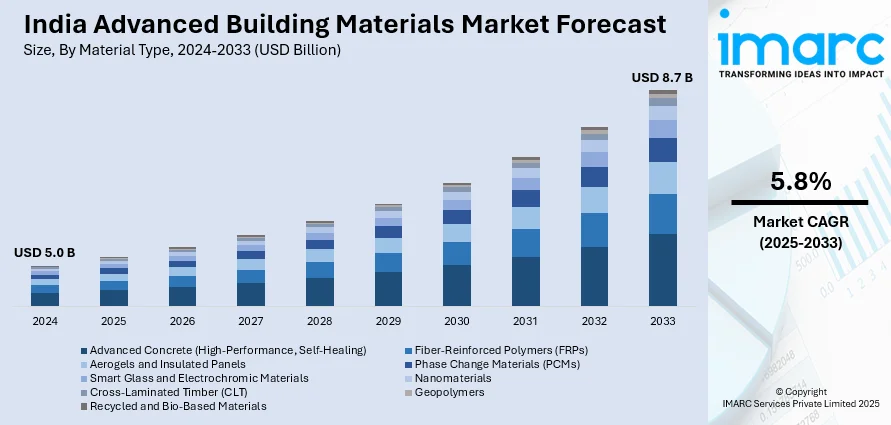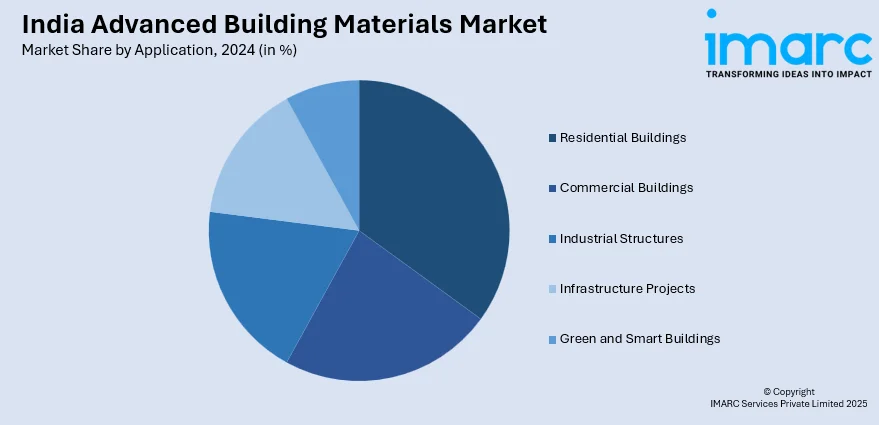
India Advanced Building Materials Market Size, Share, Trends and Forecast by Material Type, Functionality, Application, End User, and Region, 2025-2033
India Advanced Building Materials Market Overview:
The India advanced building materials market size reached USD 5.0 Billion in 2024. Looking forward, IMARC Group expects the market to reach USD 8.7 Billion by 2033, exhibiting a growth rate (CAGR) of 5.8% during 2025-2033. The market is driven by rapid urbanization, increasing focus on sustainable construction, government regulations promoting green buildings, and growing demand for energy-efficient infrastructure. Additionally, advancements in technology, rising environmental awareness, and the push for faster, cost-effective construction methods are bolstering the adoption of innovative building materials further surging the India advanced building materials market share.
|
Report Attribute
|
Key Statistics
|
|---|---|
|
Base Year
|
2024
|
|
Forecast Years
|
2025-2033
|
|
Historical Years
|
2019-2024
|
| Market Size in 2024 | USD 5.0 Billion |
| Market Forecast in 2033 | USD 8.7 Billion |
| Market Growth Rate 2025-2033 | 5.8% |
India Advanced Building Materials Market Trends:
Emphasis on Smart and Innovative Materials
Innovation is changing the face of the Indian construction sector using intelligent and technologically equipped materials. Environment-sensitive materials, such as smart glass, self-healing concrete, and intelligent insulation are becoming increasingly popular for performance optimization in buildings. These materials help achieve energy efficiency, longevity, and improved occupant comfort. Further, building practices are embracing digital technologies and automation, enabling higher precision with lower human error. The incorporation of technology-infused materials is contributing to wiser cities and stronger infrastructure. Developers and contractors are adopting these products not only due to their utilitarian benefits but also as a means to remain competitive in a changing landscape where innovation can equal long-term cost savings and better user experience thus aiding the India advanced building materials market growth.

To get more information of this market, Request Sample
Rise of Sustainable and Green Building Materials
India's construction industry is going through a revolutionary transformation as sustainability emerges as the defining pillar of infrastructure building. According to the sources, India is experiencing a strong shift toward sustainable construction practices, underscored by its investment of USD 26 billion in green buildings in 2021 a clear sign of its commitment to eco-friendly infrastructure. This transition is driven by growing environmental awareness and government-backed green initiatives. Builders and architects are increasingly adopting materials that reduce carbon emissions and energy use, such as fly ash bricks, bamboo, recycled aggregates, and eco-friendly cement. These alternatives support resource conservation while offering long-term economic and environmental advantages. Developers are also catering to a rising segment of environmentally conscious consumers who prefer green-certified homes and buildings. Beyond regulatory compliance, sustainability is seen as essential for future-proofing properties against climate risks. It is becoming a cornerstone of modern construction, shaping how India builds for a resilient and responsible future.
Growth of Prefabrication and Modular Construction
Modular and prefabricated construction is revolutionizing the way buildings are designed and constructed in India. By producing parts off-site and installing them on-site, these techniques greatly reduce construction time and labor expenses. This technique provides improved quality control, less waste, and more reliable schedules. It is particularly favored in urban and infrastructure projects where speed and scalability are paramount. The modularity also enables innovative design without causing much disruption on-site. With urbanization growing, developers are increasingly approaching prefabrication as a means of achieving tight deadlines and high demand without sacrificing quality or safety. This method is transforming efficiency in Indian construction.
India Advanced Building Materials Market Segmentation:
IMARC Group provides an analysis of the key trends in each segment of the market, along with forecasts at the country and regional levels for 2025-2033. Our report has categorized the market based on material type, functionality, application, and end user.
Material Type Insights:
- Advanced Concrete (High-Performance, Self-Healing)
- Fiber-Reinforced Polymers (FRPs)
- Aerogels and Insulated Panels
- Phase Change Materials (PCMs)
- Smart Glass and Electrochromic Materials
- Nanomaterials
- Cross-Laminated Timber (CLT)
- Geopolymers
- Recycled and Bio-Based Materials
The report has provided a detailed breakup and analysis of the market based on the material type. This includes advanced concrete (high-performance, self-healing), fiber-reinforced polymers (FRPS), aerogels and insulated panels, phase change materials (PCMS), smart glass and electrochromic materials, nanomaterials, cross-laminated timber (CLT), geopolymers, and recycled and bio-based materials.
Functionality Insights:
- Structural
- Thermal Insulation
- Acoustic Insulation
- Energy Efficiency
- Fire Resistance
- Aesthetics and Design
A detailed breakup and analysis of the market based on the functionality have also been provided in the report. This includes structural, thermal insulation, acoustic insulation, energy efficiency, fire resistance, and aesthetics and design.
Application Insights:

- Residential Buildings
- Commercial Buildings
- Industrial Structures
- Infrastructure Projects
- Green and Smart Buildings
The report has provided a detailed breakup and analysis of the market based on the application. This includes residential buildings, commercial buildings, industrial structures, infrastructure projects, and green and smart buildings.
End User Insights:
- Real Estate Developers
- Government and Public Sector
- Architects and Engineering Firms
- Contractors and Builders
A detailed breakup and analysis of the market based on the end user have also been provided in the report. This includes real estate developers, government and public sector, architects and engineering firms, and contractors and builders.
Regional Insights:
- North India
- South India
- East India
- West India
The report has also provided a comprehensive analysis of all the major regional markets, which include North, South, East, and West India.
Competitive Landscape:
The market research report has also provided a comprehensive analysis of the competitive landscape. Competitive analysis such as market structure, key player positioning, top winning strategies, competitive dashboard, and company evaluation quadrant has been covered in the report. Also, detailed profiles of all major companies have been provided.
India Advanced Building Materials Market News:
- In April 2025, JK Lakshmi Cement unveiled eco-friendly building solutions at Vibrant Buildcon 2025 in New Delhi, highlighting products like JK SmartBlox AAC Blocks, Ready Mix Concrete, and Gypsum Plaster. Senior leaders and brand ambassador Suniel Shetty attended the event, which also saw a visit from Union Minister Piyush Goyal. The company emphasized sustainable construction and its commitment to innovation, strengthening ties with industry stakeholders and reaffirming its role in India’s infrastructure growth.
- In June 2024, SIAM Cement BigBloc Construction launched its India operations with the inauguration of India's first AAC Wall plant in Kheda, Gujarat. A joint venture between BigBloc Construction Ltd and SCG International, the plant has a capacity of 2.5 lakh cubic meters per year, with an investment of Rs 65 crore. The AAC Wall products will be branded as 'ZMARTBUILD WALL by NXTBLOC', alongside AAC Blocks. This marks a significant step in advancing walling solutions in India.
India Advanced Building Materials Market Report Coverage:
| Report Features | Details |
|---|---|
| Base Year of the Analysis | 2024 |
| Historical Period | 2019-2024 |
| Forecast Period | 2025-2033 |
| Units | Billion USD |
| Scope of the Report |
Exploration of Historical Trends and Market Outlook, Industry Catalysts and Challenges, Segment-Wise Historical and Future Market Assessment:
|
| Material Types Covered | Advanced Concrete (High-Performance, Self-Healing), Fiber-Reinforced Polymers (FRPS), Aerogels and Insulated Panels, Phase Change Materials (PCMS), Smart Glass and Electrochromic Materials, Nanomaterials, Cross-Laminated Timber (CLT), Geopolymers, Recycled and Bio-Based Materials |
| Functionalities Covered | Structural, Thermal Insulation, Acoustic Insulation, Energy Efficiency, Fire Resistance, Aesthetics and Design |
| Applications Covered | Residential Buildings, Commercial Buildings, Industrial Structures, Infrastructure Projects, Green and Smart Buildings |
| End Users Covered | Real Estate Developers, Government and Public Sector, Architects and Engineering Firms, Contractors and Builders |
| Regions Covered | North India, South India, East India, West India |
| Customization Scope | 10% Free Customization |
| Post-Sale Analyst Support | 10-12 Weeks |
| Delivery Format | PDF and Excel through Email (We can also provide the editable version of the report in PPT/Word format on special request) |
Key Benefits for Stakeholders:
- IMARC’s industry report offers a comprehensive quantitative analysis of various market segments, historical and current market trends, market forecasts, and dynamics of the India advanced building materials market from 2019-2033.
- The research report provides the latest information on the market drivers, challenges, and opportunities in the India advanced building materials market.
- Porter's five forces analysis assist stakeholders in assessing the impact of new entrants, competitive rivalry, supplier power, buyer power, and the threat of substitution. It helps stakeholders to analyze the level of competition within the India advanced building materials industry and its attractiveness.
- Competitive landscape allows stakeholders to understand their competitive environment and provides an insight into the current positions of key players in the market.
Key Questions Answered in This Report
The advanced building materials market in India was valued at USD 5.0 Billion in 2024.
The India advanced building materials market is projected to exhibit a CAGR of 5.8% during 2025-2033, reaching a value of USD 8.7 Billion by 2033.
The India advanced building materials market is driven by growing urbanization, demand for sustainable and energy-efficient solutions, emphasis on eco-friendly construction practices, technological advancements in smart and innovative materials, and the increasing use of prefabricated and modular techniques to enhance construction speed, durability, and overall building performance across residential and commercial projects.
Need more help?
- Speak to our experienced analysts for insights on the current market scenarios.
- Include additional segments and countries to customize the report as per your requirement.
- Gain an unparalleled competitive advantage in your domain by understanding how to utilize the report and positively impacting your operations and revenue.
- For further assistance, please connect with our analysts.
 Request Customization
Request Customization
 Speak to an Analyst
Speak to an Analyst
 Request Brochure
Request Brochure
 Inquire Before Buying
Inquire Before Buying




.webp)




.webp)












